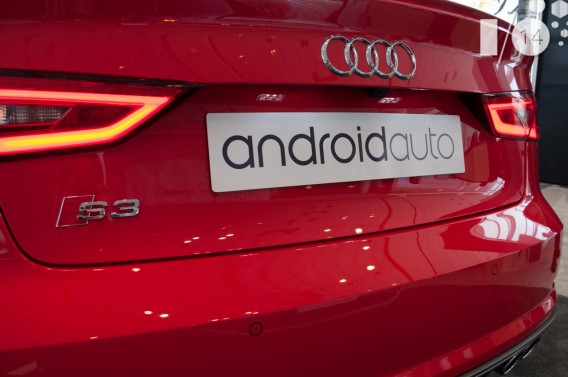There’s nothing really amazing about Android Auto. The idea is pretty basic – connect your Android phone to your car, and the Android Auto app will lock your phone and show a set of controls designed for use while driving. This includes phone calls, messaging, music, and connected car diagnostics.
At Google I/O 2014, there were a few car makers showing off cars that supported the new Android Auto platform. Since I’m not big into cars, I only recognized the Honda Civic and Audi S3 that were being used to provide short demos. The ten minute demo showed the same features from the keynote, but when sitting inside a car, it’s a little more interesting.

Touchscreen and in-car controls
The keynote showed an example of a driver using the touchscreen for Android Auto. But in the S3, it doesn’t support touchscreen, instead using the Audi MMI system. It doesn’t seem as intuitive as using a touchscreen, but Audi owners are probably used to the system. I was told that it’s up to the car manufacturer regarding what system will be used.
Your phone displayed in the car
I decided to get the demo in the Audi S3 because it’s a luxury car that I’ll probably never own. Getting in the car, an Android phone was connected to the car through USB and immediately the phone locked to show the Android Auto logo. Connection to the car is through the Android Auto app, meaning it’s not necessarily a native connection.

The interface looks like Google Now. It can show relevant information like saved direction searches and appointment information. With voice recognition, you can search for locations, and the app is designed to give you the most important information like the operating hours of a restaurant. It won’t load information like the restaurant menu, however, because Android Auto is all about keeping your focus on driving.
The in-car screen is a simplified interface with a bottom row of icons for actions. The supported features are the most obvious. Navigation through Google Maps, calls and messages, and music are the most basic. Interestingly, the icons don’t necessarily apply to first party apps; it looks like you’ll be able to use any app that supports Android Auto. The option to choose apps is under different nested menus.

Since the phone is connected to the car, any audio will play through the car’s audio system. With a lot of current cars supporting phone calls without headsets, it’s possible to chat or use voice recognition to send messages.
The music apps shown were Spotify and Google Play Music. I did ask if locally stored files would be playable, and was told that local storage was supported. The Android Auto team doesn’t want you to have to worry if you don’t have a stable network connection, like in a parking garage.

Calls through voice were demoed, but the feature isn’t really new and has been available for in-car systems for some time.
Car diagnostics
The feature I think is most interesting is the diagnostics section that Android Auto hasn’t really shown off. Being able to know more about various diagnostics on screen will be great for drivers who usually don’t pay attention. How much information car makers will display is unknown, but enthusiasts will probably enjoy it.
Still a lot unknown
The demo was shown by connecting the Android phone to the car through USB. Android Auto hasn’t explained the exact process of how the phone will connect to the car, other than that it will use the Android Auto app. It would make sense for the phone to connect wirelessly.
My colleague Lewis, a car enthusiast, is also curious if Android Auto will be compatible with older cars, because he’s “not going to buy a new car just for Android Auto.”

Android Auto could be a great platform. The support from car makers is a good sign, but the question now, is how can apps integrate into Android Auto and be useful?
The first cars with Android Auto are expected before the end of the year, and the Android Auto SDK will be available for developers to design apps for the platform. But Android Auto will need some sort of legacy support to really be adopted.
If you want more, check out my roundup of events and announcements from Google I/O.
Follow me on Twitter: @chrislikesrobot


